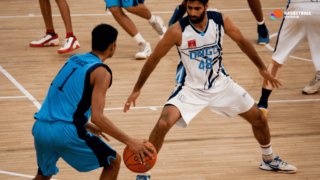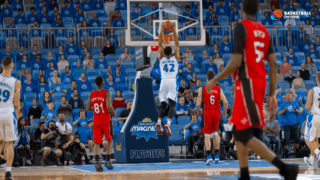Can You Play Basketball in Running Shoes?
Written by: Basketball Universe
Last updated:
When it comes to hitting the court for an exhilarating game of basketball, choosing the right footwear can often become a topic of great debate. In fact, one question that many aspiring hoopsters and casual players alike tend to ask is, “Can you play basketball in running shoes?” You’ll find that not only do opinions sway left and right, but footwear preferences can sometimes feel like an NBA playoffs rivalry. If you’re eager to lace up your runners and test your abilities on the hardwood, join us as we dribble through the ins and outs of using running shoes for basketball, and whether they can provide the support and stability necessary for making those game-winning shots.
Can You Play Basketball in Running Shoes?
While you can technically play basketball in running shoes, it is highly recommended to invest in proper basketball footwear designed for the sport. Running shoes lack the necessary ankle support, grip, and lateral stability required for quick movement changes and jumps in basketball, increasing the risk of injuries. Basketball shoes, on the other hand, are intentionally built to cater to the specific performance and safety requirements of the game.
Understanding the Differences Between Basketball and Running Shoes
When it comes to playing basketball, using the right type of shoes can make a world of difference in how you perform on the court. Although running shoes might appear to be an attractive and cost-effective option, understanding the key differences between basketball and running shoes will help you discern why it’s crucial to invest in specialized footwear.
Support and Stability
Basketball shoes are designed to provide maximum support for the player’s feet, ankles, and legs during lateral movements, quick cuts, and sudden stops. They typically feature a high-top or mid-top design, which aids in offering ankle protection and excellent stability during play. On the other hand, running shoes are designed for forward motion, with their main focus being on providing cushioning and shock absorption. This means they usually lack the necessary ankle support and stability needed for the dynamic movements basketball demands.
Traction and Grip
When maneuvering around the basketball court, maintaining a firm grip on the surface is essential to prevent slipping, which can lead to injuries. Basketball shoes are engineered with strong, non-slip outsoles, often using a herringbone pattern to optimize traction for multidirectional movements. In contrast, running shoes tend to have outsole patterns that facilitate linear motion and may not provide the level of grip needed for the swift changes of direction typically seen in basketball.
Cushioning and Impact Protection
Another aspect to consider when choosing your footwear is cushioning and impact protection. Basketball players frequently jump, land, and pivot, requiring a shoe that can minimize the strain on their joints by dispersing the impact forces. Basketball shoes often utilize advanced cushioning technologies like Nike’s Zoom Air or Adidas’s Boost to address this need. In comparison, while running shoes do feature cushioning systems, they are predominantly designed to support repeated heel-to-toe strides rather than the complex impacts experienced in basketball.
Selecting the Right Basketball Shoes for Optimal Performance
Now that you understand why wearing basketball shoes on the court is vital let’s dive into the considerations you need to make when selecting the perfect pair.
Finding Your Ideal Fit
Ensuring your basketball shoes display a snug yet comfortable fit is essential for optimal performance. Keep in mind that depending on the brand or model, sizing might vary from your regular shoe size. Take the extra time to try on different sizes and styles, considering the width, length, and even the shape of your foot. Your foot should feel secure within the shoe, without excessive sliding or pinching, leaving just enough wiggle room for your toes.
Identifying Your Playing Style
Your playing style plays a vital role in determining the type of basketball shoe that suits you best. Players typically fall into one of three categories: guards, forwards, or all-around players. Understanding your position and playing style will help guide your shoe selection process.
- Guards: These players require a lightweight shoe with excellent traction and moderate support as they rely on speed, agility, and quick cuts.
- Forwards: Larger players performing more forceful moves, such as power dunks and rebounds, necessitate high-top shoes with maximum cushioning, support, and stability.
- All-around players: Players who perform a mix of tasks on the court should opt for a versatile shoe providing a balance of support, cushioning, and flexibility.
Outsoles and Traction
As we have emphasized, traction is a key component in basketball shoes. The rubber used for outsoles varies between models and can make a significant difference in grip and durability. Ideally, a softer rubber compound will provide better traction but might wear down more quickly, particularly for outdoor court use. Harder rubber compounds tend to be more durable, but their grip can sometimes sacrifice quality in terms of grip. Be sure to consider the type of surface you will be playing on when selecting your shoes.
Maintaining Your Basketball Shoes for Longevity and Performance
Purchasing a pair of basketball shoes is an investment in your game, and like any investment, proper care is essential. By taking the following steps, you can maximize the performance and extend the life of your basketball shoes.
Keep Your Shoes Clean
Regularly cleaning the outsoles of your basketball shoes helps maintain their traction on the court. Debris, dust, and dirt can quickly accumulate on the outsole and negatively impact grip. Before and after each game or practice, use a brush or cloth to remove any dirt and debris present on the outsoles. Additionally, wiping down the upper part of your shoes can prevent odors and prolong the shoe’s aesthetic appeal.
Use Your Shoes Exclusively for Basketball
It is recommended that your basketball shoes be worn solely for playing basketball. Using your shoes for general everyday wear can lead to the premature breakdown of the cushioning and support systems. Furthermore, it can lead to unnecessary wear on the outsole, reducing the shoe’s grip and durability. By restricting your basketball shoes to use only on the court, you ensure their performance remains at its peak and extends the life of the shoes.
Dry Your Shoes Properly
After a basketball game or practice, your shoes might become damp from sweat. It’s important to let them dry properly to prevent mold growth and foul odors. To do this, stuff them with newspaper or place them in a well-ventilated area to air dry. Avoid placing your shoes directly in sunlight, near a heater, or using a dryer, as excessive heat can damage the materials in your shoes, causing them to lose their shape and support.
Can Running Shoes Be Used at All for Basketball?
Although we heavily emphasize the importance of using specialized basketball shoes for the sport, there might be times when using running shoes on the court is unavoidable. In such scenarios, prioritizing certain features in running shoes might help to minimize the risks associated with using them for basketball.
Opt for Running Shoes with Adequate Lateral Support
If you’re determined to use running shoes on the basketball court, prioritize shoe models that provide some degree of lateral support. Some running shoes feature reinforced designs in the midfoot area, with sturdier materials utilized to provide additional support. While it won’t match the level of stability found in basketball shoes, it is an ideal alternative to have in running shoes when playing basketball.
Consider Sufficient Cushioning
Since basketball requires intense movements that put pressure on your joints and feet, adequate cushioning is essential. When selecting a running shoe to be utilized for basketball, opt for models that offer additional cushioning and better shock absorption. Brands like ASICS, for instance, incorporate gel-based cushioning systems that distribute impact more evenly.
Choose Running Shoes with Traction
As previously mentioned, traction is crucial for basketball. While most running shoes may not offer the level of grip needed for the court, some do feature multidirectional traction patterns. Inspect the outsole of the running shoe to ensure it incorporates some form of multidirectional traction pattern for an improved grip on the court.
Injury Prevention Tips for Playing Basketball in Running Shoes
It’s essential to remember that using running shoes for basketball significantly increases the risk of injuries. However, should you find yourself in a situation where running shoes are your only option, here are some helpful tips to minimize injury risks:
Warm-Up and Stretch
Ensure you adequately warm up your muscles and perform stretching exercises before playing basketball. Focus on your legs, ankles, and core, as they are the primary areas of strain during the game. Warming up helps alleviate stiffness, reduce the risk of injury, and improves overall performance.
Use Ankle Support Accessories
Since running shoes lack the ankle support that basketball shoes provide, consider using external ankle support accessories like braces or wraps. These can assist in reduced ankle instability and lower the risk of injuries without compromising mobility.
Play With Caution
Lastly, remember to play with caution if you’re wearing running shoes on the court. Avoid making quick, sharp movements, and focus on staying in control of your motions. By keeping your limitations in mind, you can help minimize strain on your muscles and joints.
In conclusion, while running shoes can be worn to play basketball, wearing specialized basketball shoes is highly recommended for optimal performance, safety, and comfort. Keep in mind the distinguishing features between basketball and running shoes, and select basketball shoes that cater to your specific needs and playing style. And remember, always maintain your shoes to increase longevity and performance, so you’re ready to sink that winning shot in style!
The Evolution of Basketball Shoes to Enhance Performance
As the game of basketball has evolved over the years, so too has the footwear designed to accommodate the sport. Companies have continuously improved shoes to provide players with an edge on the court. By exploring the evolution of basketball shoes, we can gain insights into the innovations that have been developed to enhance performance and safety for players.
High-Tops: The Starting Point
Though high-top shoes had existed before the advent of basketball-specific shoes, they were not developed with the requirements of the sport in mind. The first high-top basketball shoes were manufactured by Converse in 1917, and the design quickly gained popularity among professional and amateur players alike. This early design provided basic ankle support, but they lacked the cushioning, stability, and grip of modern basketball shoes. Nonetheless, the high-top shoe set the stage for what basketball footwear should provide: ankle support for swift lateral movements on the court.
Air Technology and Enhanced Cushioning
As the game evolved, so too did the footwear. One of the significant milestones in basketball shoe technology came in 1982 when Nike introduced the Air Force 1, equipped with a revolutionary “Air” cushioning system. This utilized compressed air within a sturdy flexible sealed unit to absorb impact forces, providing players with unprecedented comfort and protection. The innovative technology was soon adopted across various brands, such as Reebok’s “Pump” system, and today, companies like Adidas have developed their own unique cushioning options, such as the Boost technology.
Ankle Support and Fit: The Emergence of Low and Mid-Tops
While high-top basketball shoes were the go-to for players in the early days of the sport, improvements in materials and design led to the development of low-top and mid-top options. These new designs offered focused ankle support while allowing for a greater range of motion, particularly important for speedier players. Certain designs, such as Nike’s Flywire, implemented lightweight cables within the shoe structure to provide extra support and strength without sacrificing mobility. Low and mid-top shoes have since become popular options for players who prioritize speed and agility.
Modern Innovations: Embracing Personalized Performance
Recent innovations in basketball footwear have aimed to provide customized support for players, accounting for individual preferences and playing styles. Some examples include Under Armour’s HOVR cushioning system, allowing athletes to choose their preferred level of cushioning and responsiveness, or the Adidas Harden line, designed specifically to accommodate the playing style of James Harden. With constantly evolving technology in the basketball footwear industry, future advancements will likely continue to focus on individualization and tailoring shoes to conform to each player’s unique requirements.
Can You Customize Running Shoes for Basketball?
If you’re prepared to purchase new shoes and specifically desire a pair capable of handling both running and basketball, it may be worth exploring custom options from various sports brands. Both Nike and Adidas offer customization options for select models, enabling you to adjust certain features according to your preferences. However, while this may be a viable option for casual players, it’s essential to understand that customized running shoes will likely still fall short of basketball-specific shoes in terms of safety, support, and performance.
Frequently Asked Questions: Basketball and Running Shoes
If you’re curious about the intersection of basketball and running shoes, we’ve compiled a list of frequently asked questions to help address any lingering concerns. Equip yourself with the knowledge needed to make an informed decision when it comes to choosing the right footwear for basketball.
1. How often should I replace my basketball shoes?
The lifespan of basketball shoes can vary depending on factors such as frequency of use, playing style, and shoe quality. A general rule of thumb is to replace basketball shoes every 6 to 12 months, depending on signs of wear and the breakdown of support systems.
2. Can I wear low-top basketball shoes?
Yes, low-top basketball shoes can be worn by players who prioritize speed and focus on agility during gameplay. These shoes typically offer a greater range of motion compared to high-top shoes but may provide slightly less ankle support.
3. What type of basketball shoes are best for outdoor courts?
When playing on outdoor courts, durability and traction are key considerations. Look for basketball shoes with harder rubber outsoles, as they tend to wear out less quickly on asphalt and concrete surfaces than softer rubber compounds.
4. How tight should basketball shoes fit?
Basketball shoes should fit snugly yet comfortably, ensuring your foot feels secure within the shoe without excessive sliding or pinching. Give your toes just enough wiggle room to prevent discomfort and reduce the risk of injury.
5. How do I know if my basketball shoes have adequate grip?
Basketball shoes with good grip will have a non-slip outsole, often featuring a herringbone pattern or other multidirectional traction designs. To assess the quality of the grip, consider running, pivoting, and making quick stops on the court to ensure the shoe holds firm, preventing slippage.
6. Can I purchase basketball shoes online?
While it is possible to buy basketball shoes online, it’s essential to know your size and fit preferences before purchasing. Consider trying on a variety of styles and brands in-store before buying online, focusing on elements like width, length, and shape to suit your foot.
7. Are there basketball shoes specifically designed for wide feet?
Yes, certain basketball shoe models and brands may cater specifically to individuals with wide feet. Brands such as New Balance and Under Armour are known for providing wider options in their shoe selections, so explore these when browsing for the perfect fit.
8. Can I wear insoles or orthotics with basketball shoes?
Yes, many basketball shoes are designed to accommodate additional insoles or custom orthotics. These can provide extra cushioning and arch support, ensuring that your feet remain comfortable throughout gameplay.
9. Are there any alternatives to popular basketball shoe brands?
While well-known brands such as Nike, Adidas, and Under Armour tend to dominate the basketball shoe market, there are alternative options to consider. Companies like Puma, Reebok, and Peak offer basketball shoes designed for various playing styles, providing support and performance enhancements.
10. Can basketball shoes be used for other sports or activities?
While basketball shoes can be worn for some other sports or activities, it’s important to remember that they’ve been specifically designed for the demands of basketball. Using them for other sports might limit optimal performance or increase the risk of injury.
11. Do some basketball shoes help with arch support?
Yes, many basketball shoes feature designs that cater to players requiring additional arch support. Look for shoes with a structured and reinforced midfoot area or consider using custom insoles or orthotics to provide the arch support you need.
12. Can basketball shoes help prevent injuries?
Wearing basketball-specific shoes can lower the risk of injuries by providing the necessary ankle support, grip, and lateral stability required for the rigorous movements of the game. Selecting a shoe that aligns with your playing style and foot type can further contribute to injury prevention.
13. What factors should I consider when buying basketball shoes for my child?
When purchasing basketball shoes for children, focus on finding the appropriate shoe size, ensuring a comfortable and secure fit, and selecting a shoe with an appropriate amount of cushioning and support for their specific needs. Pay attention to the shoe’s durability as well, especially if they will be playing on different types of surfaces.
Featured Posts
- No pillar pages found.





